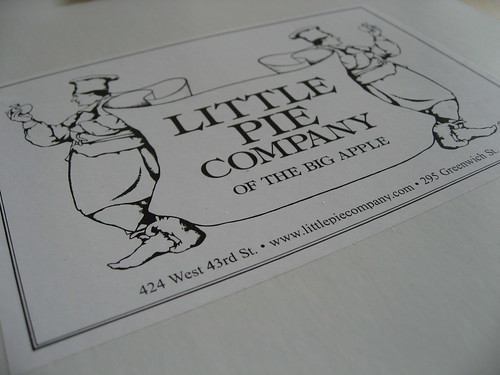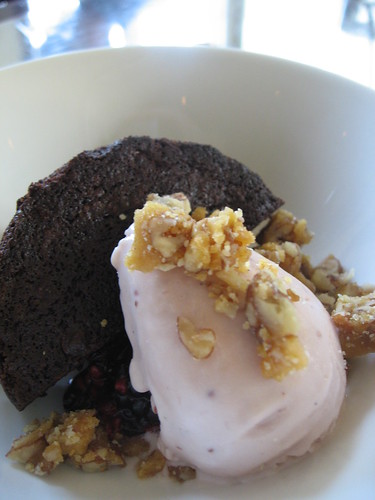Clearly Nathan Heller at Slate hasn't eaten Little Pie Company's apple pie. Or read my blog post about how freakin' delicious this stuff is
Pie: It's gloppy, it's soggy, it's un-American.
Showing posts with label American food. Show all posts
Showing posts with label American food. Show all posts
Wednesday, June 29, 2011
Friday, March 25, 2011
Speaking of airport food
Following up on my comments on David Lebovitz's proposals for better food at Charles de Gaulle airport in Paris, this gets me very, very excited for what travellers can look forward to at the new Terminal 2 of San Francisco airport:
SFO Terminal 2 to include sustainable food
Though I'm a sustainable food advocate, it's not just food for hippies (though, befitting for one's aviation gateway to the land of Haight and Ashbury, no?). Famous household names like Tyler Florence and Cat Cora will have their own culinary outposts, and The Burger Joint and Pinkberry will also have a presence.
Being the foodie that I am, though, I'm most excited about Napa Farms Market, a "5,000-square-foot gourmet food emporium designed by BCV, the firm responsible for the Ferry Building Marketplace." The Ferry Building (and even more impressive, the farmer's market that is held there on Tuesdays, Thursdays, and Saturdays), is one of the quintessential San Francisco destinations, along with the Golden Gate Bridge and cable car lines.
In fact, to be honest, though the Ferry Building is beautiful and full of unique foodie finds, it's got a bit of a hoity-toity air on non-farmer's market days. But when the outside area around the Ferry Building gets packed in front and in back with stalls selling amazing veggies, fruits, honey, mushrooms, grilled-to-order grass-fed burgers and sausages, and with everyone handing out generous samples of their goodies... well, words just fail me. You have to see it to believe it.
I'm guessing that even the best attempts at improving airport food will still fall short of that magic, though it sure sounds like they're going to try:
SFO Terminal 2 to include sustainable food
Though I'm a sustainable food advocate, it's not just food for hippies (though, befitting for one's aviation gateway to the land of Haight and Ashbury, no?). Famous household names like Tyler Florence and Cat Cora will have their own culinary outposts, and The Burger Joint and Pinkberry will also have a presence.
Being the foodie that I am, though, I'm most excited about Napa Farms Market, a "5,000-square-foot gourmet food emporium designed by BCV, the firm responsible for the Ferry Building Marketplace." The Ferry Building (and even more impressive, the farmer's market that is held there on Tuesdays, Thursdays, and Saturdays), is one of the quintessential San Francisco destinations, along with the Golden Gate Bridge and cable car lines.
In fact, to be honest, though the Ferry Building is beautiful and full of unique foodie finds, it's got a bit of a hoity-toity air on non-farmer's market days. But when the outside area around the Ferry Building gets packed in front and in back with stalls selling amazing veggies, fruits, honey, mushrooms, grilled-to-order grass-fed burgers and sausages, and with everyone handing out generous samples of their goodies... well, words just fail me. You have to see it to believe it.
I'm guessing that even the best attempts at improving airport food will still fall short of that magic, though it sure sounds like they're going to try:
"Napa Farms will be studded with familiar names - Acme Bread, Cowgirl Creamery [both of which also have locations at the Ferry Building], Three Twins Ice Cream - as well as a bounty of seasonal produce from local farms. There will also be "picnic boxes" available for takeout, and Vino Volo will open a Bay Area-focused wine bar."As a San Francisco native, I am thrilled about the image of the city such food options at the airport will project. That said, I know that this kind of food comes at a cost, and the downside is that the prices will turn people off from "San Francisco" food, and reinforce the idea that good, sustainable food is just a project of the elite. Then again, airport food has always suffered from dubious price-gouging -- at least this time it can come with some local flavor and flair?
Thursday, February 24, 2011
America’s Food Image Needs to Get a Move On
(cross-posted from a class assignment to write an op-ed)
As Michelle Obama’s Let’s Move initiative to eliminate obesity within one generation celebrated its one-year anniversary last week, it has yet to shake its critics. Most recently, Rush Limbaugh decried the First Lady as a hypocrite on his radio show Tuesday for indulging in short ribs while in Vail, Colorado for the long weekend. Yet it’s no wonder some have cited the First Lady’s project as an example of “nanny state” interventions; should she finally solve the age-old question of how to get kids to eat their vegetables, parents the world over might pronounce her a modern-day Mary Poppins.
I am not a parent, however, and probably should not conjecture on the role of government in parent-child mealtime struggles. Rather, as an international communication student who looks at the way food represents and constructs messages about culture, I see in the First Lady’s campaign an as-yet unrecognized potential to reform international perceptions of American food, and of Americans themselves.
While critics of Michelle Obama’s initiative deride what they perceive as the elimination of freedom of choice, as a nation we have failed to see that our underinvestment in a healthy food system has larger international implications than our individual eating decisions. America has some of the most talented chefs in the world, some of the most bountiful produce belts, and a whole holiday dedicated to (let’s be honest) stuffing ourselves silly. Yet no American city made it into the top 5 of the Anholt-GFK Roper City Brand index cities for eating in 2009, based on the impressions of 10,000 people representing 20 countries. Ask a foreigner what American food is, and they’ll likely say something about pizza, hamburgers, French fries, etc. They might mention processed foods or fast food, or simply give the one-word answer, “McDonalds.” Some people (probably French) might scoff and say with a sneer, “There is no American cuisine.”
To take one example of how the Let’s Move initiative can change these perceptions, consider the national school lunch program. Founded in 1946, the program provided lunch every day to more than 31.3 million children in 2009. School lunches play an integral role in ensuring that, per Michelle Obama’s vision, government subsidized meals for kids do not contribute to rising rates of childhood obesity. Yet, if the recent Jamie Oliver’s Food Revolution TV program is any indication, school lunch administrators currently fail at this task so completely that, as with most things, we apparently need to call in the real experts: the British. With all due respect to the Naked Chef and his countrymen, that foggy grey isle has hardly been known as a historical hotbed of haute or even healthy cuisine, what with its mushy peas, boiled beef, and beans on toast.
Michelle Obama’s Let’s Move initiative is an opportunity to reform not only what the world thinks about American food, but what they, by extension, think about Americans. What message do we send to the world when the most prosperous nation spends less than $1 per eligible child for ingredients for lunch? How little do we value American children that they get the cast-offs of large industrial food companies, not because these foods are nutritious, but because they can’t be sold elsewhere? And who is to take on the patriotic American torch when we are seeing the first generation of kids expected to live shorter lives than their parents due to diet-related disease?
Americans are often criticized for lacking a real culture, and thus for lacking a real cuisine. But a national school lunch program that reinforces the vision of a fit and healthy youth can be a start in building a national food identity that conveys more than just overindulgence, laziness, and convenience. Some might scoff at the idea of increasing America’s international prowess through reformed school lunch programs, but soft power matters. How the rest of the world sees us invest in our children’s health sends a message about who will be leading this country in the future. And though it is a bitter pill to swallow that we have thus far underinvested our energy and resources in properly nourishing our kids, now is the time to demonstrate that we are up to the task, and don’t mind saving that spoonful of sugar for special occasions.
As Michelle Obama’s Let’s Move initiative to eliminate obesity within one generation celebrated its one-year anniversary last week, it has yet to shake its critics. Most recently, Rush Limbaugh decried the First Lady as a hypocrite on his radio show Tuesday for indulging in short ribs while in Vail, Colorado for the long weekend. Yet it’s no wonder some have cited the First Lady’s project as an example of “nanny state” interventions; should she finally solve the age-old question of how to get kids to eat their vegetables, parents the world over might pronounce her a modern-day Mary Poppins.
I am not a parent, however, and probably should not conjecture on the role of government in parent-child mealtime struggles. Rather, as an international communication student who looks at the way food represents and constructs messages about culture, I see in the First Lady’s campaign an as-yet unrecognized potential to reform international perceptions of American food, and of Americans themselves.
While critics of Michelle Obama’s initiative deride what they perceive as the elimination of freedom of choice, as a nation we have failed to see that our underinvestment in a healthy food system has larger international implications than our individual eating decisions. America has some of the most talented chefs in the world, some of the most bountiful produce belts, and a whole holiday dedicated to (let’s be honest) stuffing ourselves silly. Yet no American city made it into the top 5 of the Anholt-GFK Roper City Brand index cities for eating in 2009, based on the impressions of 10,000 people representing 20 countries. Ask a foreigner what American food is, and they’ll likely say something about pizza, hamburgers, French fries, etc. They might mention processed foods or fast food, or simply give the one-word answer, “McDonalds.” Some people (probably French) might scoff and say with a sneer, “There is no American cuisine.”
To take one example of how the Let’s Move initiative can change these perceptions, consider the national school lunch program. Founded in 1946, the program provided lunch every day to more than 31.3 million children in 2009. School lunches play an integral role in ensuring that, per Michelle Obama’s vision, government subsidized meals for kids do not contribute to rising rates of childhood obesity. Yet, if the recent Jamie Oliver’s Food Revolution TV program is any indication, school lunch administrators currently fail at this task so completely that, as with most things, we apparently need to call in the real experts: the British. With all due respect to the Naked Chef and his countrymen, that foggy grey isle has hardly been known as a historical hotbed of haute or even healthy cuisine, what with its mushy peas, boiled beef, and beans on toast.
Michelle Obama’s Let’s Move initiative is an opportunity to reform not only what the world thinks about American food, but what they, by extension, think about Americans. What message do we send to the world when the most prosperous nation spends less than $1 per eligible child for ingredients for lunch? How little do we value American children that they get the cast-offs of large industrial food companies, not because these foods are nutritious, but because they can’t be sold elsewhere? And who is to take on the patriotic American torch when we are seeing the first generation of kids expected to live shorter lives than their parents due to diet-related disease?
Americans are often criticized for lacking a real culture, and thus for lacking a real cuisine. But a national school lunch program that reinforces the vision of a fit and healthy youth can be a start in building a national food identity that conveys more than just overindulgence, laziness, and convenience. Some might scoff at the idea of increasing America’s international prowess through reformed school lunch programs, but soft power matters. How the rest of the world sees us invest in our children’s health sends a message about who will be leading this country in the future. And though it is a bitter pill to swallow that we have thus far underinvested our energy and resources in properly nourishing our kids, now is the time to demonstrate that we are up to the task, and don’t mind saving that spoonful of sugar for special occasions.
Friday, January 28, 2011
Diplomacy on a plate
Tasting Table's newsletter for today (national edition) notes that chefs have recently been combining the classic French dish, duck confit, with American comfort foods.
A homey French staple cozies up to American classics
If only real diplomatic relations were so easy as combining one's national foods with others... then again, if Tyler Florence's duck confit and waffles dish at Rotisserie and Wine is as good as Tasting Table describes it, I'd probably be ready to sign any treaty you put in front of me.
A homey French staple cozies up to American classics
If only real diplomatic relations were so easy as combining one's national foods with others... then again, if Tyler Florence's duck confit and waffles dish at Rotisserie and Wine is as good as Tasting Table describes it, I'd probably be ready to sign any treaty you put in front of me.
Monday, August 30, 2010
A regional food concept and international inspiration
I have much to catch up on, but for now, some interesting articles:
More than just eating local: Home Grown
Sean Brock is opening a restaurant in South Carolina called Husk, where the cuisine will be firmly rooted in the South: if it's not grown there, or if it's not historically related to the area, no dice. An interesting twist on the idea of eating local (or, in his case, regional), in the geographical, historical, *and* cultural contexts of the word.
Relatedly, though ironically taken to an international context, Brad Farmerie thinks global cuisine is more than just combining exotic ingredients: World Chefs: Farmerie says global cuisine should be focused
It's only a short Q and A, but he touches upon the idea of using ingredients in the context of the cultures from whence they're derived, rather than just willy nilly throwing things on a plate. Culture matters!
Which is maybe something restaurateurs/chefs should take to heart before considering following QSR's suggestion to shake things up by drawing inspiration from other food cultures: Driving innovation through international inspiration
Then again, Falafoul, a Saudi Arabia-based chain of fast-food restaurants has apparently incorporated "international flavors like Greek, Italian and Mexican" into their falafel sandwiches. Apparently they're looking to expand into the US market; if they succeed, I'd be intrigued to see how such international flavors might get reinterpreted through "traditional Arabic" eyes for an American audience.
More than just eating local: Home Grown
Sean Brock is opening a restaurant in South Carolina called Husk, where the cuisine will be firmly rooted in the South: if it's not grown there, or if it's not historically related to the area, no dice. An interesting twist on the idea of eating local (or, in his case, regional), in the geographical, historical, *and* cultural contexts of the word.
Relatedly, though ironically taken to an international context, Brad Farmerie thinks global cuisine is more than just combining exotic ingredients: World Chefs: Farmerie says global cuisine should be focused
It's only a short Q and A, but he touches upon the idea of using ingredients in the context of the cultures from whence they're derived, rather than just willy nilly throwing things on a plate. Culture matters!
Which is maybe something restaurateurs/chefs should take to heart before considering following QSR's suggestion to shake things up by drawing inspiration from other food cultures: Driving innovation through international inspiration
Then again, Falafoul, a Saudi Arabia-based chain of fast-food restaurants has apparently incorporated "international flavors like Greek, Italian and Mexican" into their falafel sandwiches. Apparently they're looking to expand into the US market; if they succeed, I'd be intrigued to see how such international flavors might get reinterpreted through "traditional Arabic" eyes for an American audience.
Sunday, May 16, 2010
As American as Apple Pie

Around the time of my last post, my friend Amy came down from New York to visit, a trip that happened to coincide with my birthday. Instead of a birthday cake, however, she came with a Sour Cream Apple Walnut Pie from the Little Pie Company.

People. PEOPLE. I cannot fully express how much I love this pie. I cannot tell you, nor can pictures really do justice to just how amazingly delicious this pie is.* The first time I tasted the gloriousness that is this pie, all I could think was, "Holy hell, this pie is GOOD." Science (and the shop's website) tells me that the amalgamation of crisp apples, brown sugar, cinnamon, and maybe some nutmeg has something to do with all this, but all I ever think is, "Holy hell this pie is GOOD." I've had good apple pies before -- a now-retired apple pie from San Francisco bakery, Just Desserts is legendary in my family, and I used to be addicted to a cafeteria apple pie in high school that had a great French crumb topping -- but none of them have made me say, "Holy hell this pie is GOOD."

Lest you think this a matter of personal taste, Exhibit A: two additional friends also in town for the weekend, skeptical of my profused love for this pie, but willing to indulge me in the partaking of my birthday deliciousness. Sam requested a small slice, nonchalantly took a bite, and then said, "Wow... this is GOOD." Minutes later, both friends were going back for (larger) seconds.

Okay, I said I couldn't fully express how much I love this pie, but I'll try to be more specific beyond just telling you that it's GOOD. There's no mass of syrupy sweet pie goo drowning everything else. The thinly sliced apples (way preferable to big hunks IMHO) are still firm with a little bite, not mushy like some overripe apple that's been sitting on your counter for too long. I have no idea where the sour cream comes in, but if that's what makes this pie so amazing, then I'm not questioning it. I'm not one to generally like nuts in my baked goods either, but if the absence of walnuts changed this pie in any way, I would have none of it.

Which brings me back to my last post, and the "most unloved" foods. Note that neither apples nor pie appear on the list (nor sour cream nor walnuts for that matter). Clearly, then, if any country was looking for a specific food to be its cultural ambassador to the world this would be it. I think adopting this pie as THE pie as in, "As American as apple pie" could even do wonders for internal patriotism. As it is, I'm sometimes skeptical of being labeled, "American" and its attendant connotations, but if someone ever likened me to the Little Pie Company's Sour Cream Apple Walnut Pie, I'd say, "Heck yes, with an oven and a fork at the ready!"
*Disregard the brick-like quality of the pie in these pictures; unfortunately the heated version wasn't quite as photogenic. That said, make no mistake: pictures or no pictures, this pie is delicious hot or cold.
Friday, April 16, 2010
Global foodies unite!
Look, another one!
Great Dining Deals in Paris
I'm actually feeling okay about just posting this link without saying much about it because it pretty much captures most of my thoughts on food and the culture of fine dining in itself. I have yet to read any of David Lebovitz's books, but I visit his blog almost every day for the beautiful pictures, witty self-deprecations, and glimpse into the (sweet) life of an American transplant in Paris.
Coincidentally, I also ran across this interview with "celebrity" chef Thomas Keller, in which he asserts that diners across the country (like NYC vs. Napa valley) don't really differ from one another, "because when you're dealing at that high-end level, it's the same type of client. It's the person that appreciates the quality."
Thomas Keller on Running a Culinary Empire
(you may have to register to read the whole interview)
Which all, I think, speaks to a culture of fine dining and haute cuisine specifically, as well as a culture of foodie-ism more generally, that transcends geographical locations and even national cultures. Keller's empire doesn't yet extend outside the United States, and I'd be intrigued to see if his theory about high-end diners might change once it did. But even though national cultures might value food differently, I think he's onto something. Perhaps we can start thinking of foodies around the world as their own diaspora (can you have a diaspora without an originating homeland?), united in the imagined nation-state of deliciousness.
But only if our (imagined) national dish can be the strawberry ice cream with peanut brittle and brownie from Thomas Keller's Ad Hoc, the cookbook for which I, also coincidentally, just received as an early birthday gift yesterday.

*Full disclosure: Thomas Keller has yet to pay me to eat at Ad Hoc, but should he do so one day, I would accept in a heartbeat.
Great Dining Deals in Paris
I'm actually feeling okay about just posting this link without saying much about it because it pretty much captures most of my thoughts on food and the culture of fine dining in itself. I have yet to read any of David Lebovitz's books, but I visit his blog almost every day for the beautiful pictures, witty self-deprecations, and glimpse into the (sweet) life of an American transplant in Paris.
Coincidentally, I also ran across this interview with "celebrity" chef Thomas Keller, in which he asserts that diners across the country (like NYC vs. Napa valley) don't really differ from one another, "because when you're dealing at that high-end level, it's the same type of client. It's the person that appreciates the quality."
Thomas Keller on Running a Culinary Empire
(you may have to register to read the whole interview)
Which all, I think, speaks to a culture of fine dining and haute cuisine specifically, as well as a culture of foodie-ism more generally, that transcends geographical locations and even national cultures. Keller's empire doesn't yet extend outside the United States, and I'd be intrigued to see if his theory about high-end diners might change once it did. But even though national cultures might value food differently, I think he's onto something. Perhaps we can start thinking of foodies around the world as their own diaspora (can you have a diaspora without an originating homeland?), united in the imagined nation-state of deliciousness.
But only if our (imagined) national dish can be the strawberry ice cream with peanut brittle and brownie from Thomas Keller's Ad Hoc, the cookbook for which I, also coincidentally, just received as an early birthday gift yesterday.

*Full disclosure: Thomas Keller has yet to pay me to eat at Ad Hoc, but should he do so one day, I would accept in a heartbeat.
Subscribe to:
Posts (Atom)



